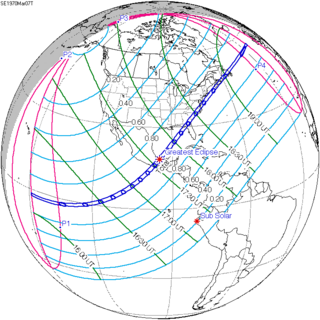Solar eclipse of March 7, 1970
| Solar eclipse of March 7, 1970 | |
|---|---|
| Type of eclipse | |
| Nature | Total |
| Gamma | 0.4473 |
| Magnitude | 1.0414 |
| Maximum eclipse | |
| Duration | 208 sec (3 m 28 s) |
| Coordinates | 18°12′N 94°42′W / 18.2°N 94.7°W |
| Max. width of band | 153 km (95 mi) |
| Times (UTC) | |
| Greatest eclipse | 17:38:30 |
| References | |
| Saros | 139 (27 of 71) |
| Catalog # (SE5000) | 9442 |
The total solar eclipse of March 7, 1970 was visible across all of North America and Central America. A solar eclipse occurs when the Moon passes between Earth and the Sun, thereby totally or partly obscuring the image of the Sun for a viewer on Earth. A total solar eclipse occurs when the Moon's apparent diameter is larger than the Sun's, blocking all direct sunlight, turning day into darkness. Totality occurs in a narrow path across Earth's surface, with the partial solar eclipse visible over a surrounding region thousands of kilometres wide. Totality was visible across southern Mexico and across the southeast coast of the United States and Canada. Greatest eclipse occurred over Mexico, with totality lasting 3 minutes and 28 seconds. Totality over the United States lasted up to 3 minutes and 10 seconds. There will not be an eclipse with a greater duration of totality over the contiguous United States until the solar eclipse of April 8, 2024, a period of 54 years.
The March 7 eclipse slowed a radio transmission of atomic time from North Carolina to Washington, D.C.

Animation of eclipse path (3 minutes per frame)
Each member in a semester series of solar eclipses repeats approximately every 177 days and 4 hours (a semester) at alternating nodes of the Moon's orbit.
It is a part of saros series 139, repeating every 18 years, 11 days, containing 71 events. The series started with partial solar eclipse on May 17, 1501. It contains hybrid eclipses on August 11, 1627 through December 9, 1825 and total eclipses from December 21, 1843 through March 26, 2601. The series ends at member 71 as a partial eclipse on July 3, 2763. Members in the same column are one exeligmos apart and thus occur in the same geographic area.
...
Wikipedia

